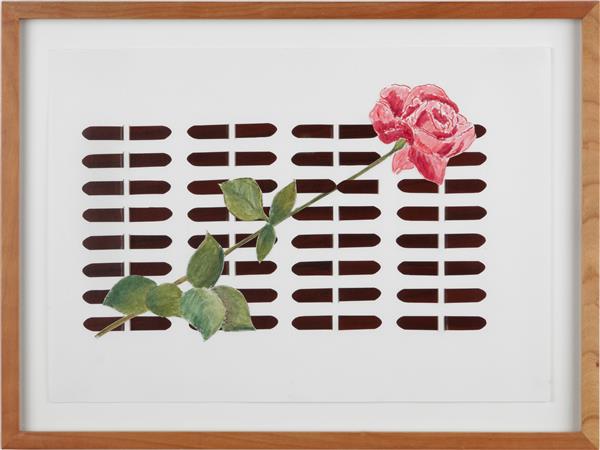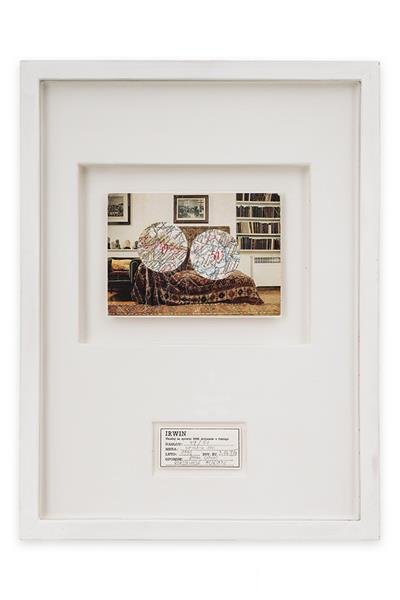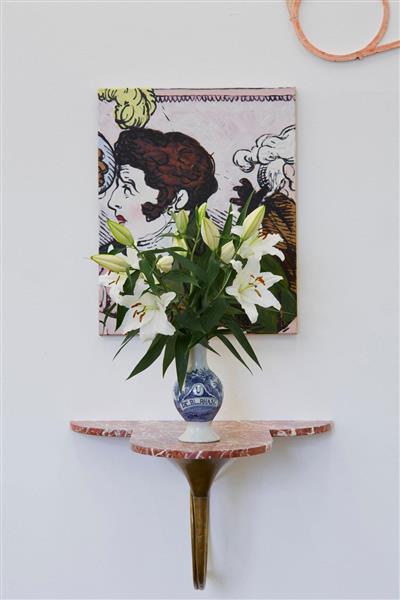Untitled
Yuri Leiderman
collage and plastic incrustation on paper
38 × 50 cm
2005
Acquisition 2009
Inv. No. 0192
In January 2010, a lively group was marching through the wintry city of Amsterdam, holding up photographs of Anne Frank and her family mounted on poles and carrying a pedestal featuring painted mushroom sculptures. All the time, the group members were intoning meaningless phrases. An absurd spectacle, this initiative had been anticipated by a collage Yuri Leiderman made in 2005. Besides mind-expanding mushrooms, its title – Anne Frank’s father and mushrooms of consciousness expansion (Geopoetics-2) – refers to the literary term geopoetics,1 which Leiderman uses for a series of performative installations.2
In his works, Leiderman, who was born in Ukraine and studied chemical engineering in Moscow in the 1980s, where he was also a co-leader of the local underground scene,3 pursues a close compound of literature, actionism, and the visual arts. Geopoetics, which actually deals with the correlations between geographical spaces and literary concepts, is treated here from a visual and performative perspective. Many aspects have been preconceived in the collages, which can be regarded as stage designs. The imagery is clearly laid out and makes use of common motifs or stereotypes that form part of a globally comprehensible visual memory. Realistically drawn figures of diverse origins, often dressed in their native costumes, are transferred to different places or alien situations. National identity is first constructed and subsequently dissolved through partly grotesque exaggeration. In the performances, these figures and symbols can become reality, yet because of their confrontational combination with all the other elements, reality is turned into a construction and provocation even more so. There is no logic behind these images, although they are frequently based on scientific material. Such as the realistic rose, they appear to be metaphors, but they cannot and should not be deciphered. Yuri Leiderman: “That’s how our geopoetics arises, in free and perverse reciprocity with geopolitics, using the energy of world events but expressing nothing, an effect-possibility which has existed since before the world began and will still be here after it ends.”4
Heike Maier-Rieper, 2011 (translation: Wolfgang Astelbauer)
1) See Magdalena Marszałek, Sylvia Sasse (eds.), Geopoetiken. Geographische Entwürfe in den mittel- und osteuropäischen Literaturen, Berlin 2010.
2) Currently, there exist 15 series, partly in different variants. For Geopoetics-2, for example, there is a Shanghai version (2004), a Budapest version (2005), a Birmingham version (2007), a Moscow version (2010), and the Amsterdam version described above.
3) Until 1990, Leidermann was a member of the group Medical Hermeneutics (with Pavel Pepperstein and Sergei Anufriev)
4) Yuri Leiderman. Ensemblement, Le Quartier/Quimper 2004, 134.
Continue readingPublications
evn collection. 2006–2011, Cologne 2011, p. 266–269


